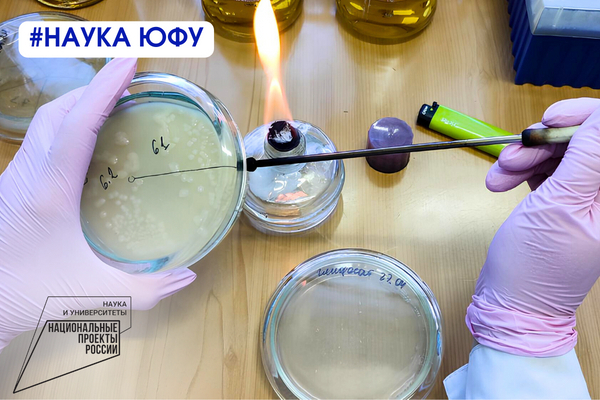
SFedU scientists have proved that roundup, which is popular in agriculture, is dangerous for soil fertility and agrobiosafety in any concentration due to its toxic effects, which contradicts the goals of sustainable development of agriculture in the Russian Federation.
Glyphosate (roundup) is a non–selective systemic herbicide used for weed control. Since the appearance of roundup, there have been discussions among scientists for more than a decade about its potential harm to both human health and the environment. Some experts claim that at low concentrations the herbicide is absolutely harmless, while others say that even a small amount of glyphosate causes irreparable harm to nature.
Roundup is most often used in agriculture. Ideally, it should help to get rid of weeds and not have a negative effect on the soil and agricultural products. However, in a recent study, scientists from the Academy of Biology and Biotechnology of the Southern Federal University studied the effect of this herbicide on the soil microbiome, and identified its danger even at low concentrations. The results of this work are useful for agriculture, where there is a need to find alternative herbicides safer for the microbial community of soils, as well as for healthcare: the mutagenic properties of roundup have been established. It is necessary to study its carcinogenic properties more carefully and, accordingly, find less harmful alternatives.

"The aim of our study was to establish the effect of glyphosate on the model bacterial population. E.coli (E.coli) was chosen as a model microorganism – the most studied bacterium, most often used in experimental studies – a kind of "white mouse" of microbiology. In the course of our work, the effect of glyphosate on the formation of bacterial biofilms (biofilms are a common life form of soil bacteria), integral toxicity, metabolic rate, damage to proteins and bacterial cell membranes was evaluated. We also assessed changes in the level of oxidative stress and mutagenesis under the influence of glyphosate," said Ivan Sazykin, a leading researcher at the Laboratory of Ecology and Molecular Biology of Microorganisms, Professor of the Department of Biochemistry and Microbiology at the Academy of Biology and Biotechnology.
Thus, the scientists examined the effects of four concentrations of the herbicide recommended for agrotechnical use, as well as 1/10, 1/100 and 1/1000 of this concentration. It was found that glyphosate suppresses the formation of bacterial biofilms in all concentrations studied.
"It is especially important, in our opinion, that in the two lower concentrations studied, glyphosate exhibits genotoxic properties and enhances mutagenesis. At the same time, my colleagues and I had a wide discussion about an article by American researchers who claimed that glyphosate as a mutagen is safe, since it suppresses mutagenesis in recommended concentrations. We have shown that this is due to a general suppression of metabolism (metabolic rate) in the bacterial cell, manifestations of integral toxicity, damage to proteins and membranes of the bacterial cell, as well as increased oxidative stress in it. In this case, the concentration of glyphosate decreases, the level of mutagenesis increases," Ivan Sazykin stressed.
Various chemicals for use in agriculture are constantly being created by research chemists specializing in the synthesis of new organic compounds. However, over time, with the advent of experience in the widespread use of this drug, its negative sides begin to emerge. The search begins for other, no less (and better – more) effective drugs that are devoid of the shortcomings of their predecessors. It is a continuous cyclical process.
"The search for new, safer substances is constantly going on, but it is always economically more profitable for a manufacturer to produce and sell already used drugs than to invest time and money in the development of new ones. Many users are more accustomed to using already known and effective drugs than to think about the negative consequences of their use. The rejection of old drugs usually occurs only after serious evidence of their harmful effects by the scientific community. That is, there is always an assessment of the balance between the benefits and harms of using the drug. When the negative consequences outweigh in the public consciousness, they refuse to use the drug," Ivan Sazykin noted.
According to the author of the article, the microbiome is an important component of maintaining the properties and fertility of the soil. Degradation of the soil microbial community can definitely affect its fertility and sustainable agricultural development. However, it is impossible to make specific predictions about the decrease in fertility as a result of the use of roundup and its analogues. At the same time, due to the need to find a safe alternative to roundup, the share of biotechnological methods of agriculture and, in general, the role of biotechnologies in agricultural production will increase significantly in the coming years.
"The manufacturing company invested enormous resources in the development and production of not only the roundup itself, but also transgenic "Roundup Ready" crops, after which it obsessively promoted its developments. Such plants are resistant to glyphosate – if processed in time with a roundup, then there will be no weeds, and the target crop will grow as if nothing had happened – this is convenient. Besides, farmers get used to it, and it's expensive and unusual to change something. And the final touch is that roundup–resistant weeds have already appeared," Ivan Sazykin said

The research was carried out with the financial support of the Ministry of Science and Higher Education of the Russian Federation within the framework of the state assignment in the field of scientific activity No. FENW-2023–0008. The results of the study are presented in the scientific journal "J Hazard Mater".
Short link to this page sfedu.ru/news/75288




